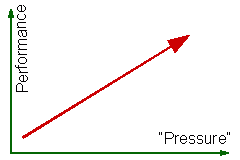Drive Theory

Research by Hull (1943) and Spence and Spence (1966).
A proportional linear relationship between arousal and performance.
The more a sports person was aroused the better their performance OR P= H X D.
Hull thought drive was synonymous with arousal.
The habit strength was a learned behaviour/ dominant response which occurred more often as drive levels increased.
Key component is performer’s level of skill & sees the relationship between arousal & performance as linear: performance increases in proportion to arousal.
A very high arousal level would result in a high performance level, provided skill is well-learned. However, if the skill is not well-learned, performance of skill will deteriorate as arousal increases.
This theory helps explain why beginners find it difficult to perform well under pressure. Often beginners skill level decreases if they are competing in a relay race using new skills, e.g. football dribbling race. However, also explains how experienced athletes perform better under pressure using well-learned skills, e.g. good tennis players play better against stronger opposition.
Clearly the impact of arousal on performance is complex, consider the following:
Ed Moses, Olympic medal winner (1976 & ’84 400m hurdles) said ‘the way I get the best out is by not expecting an easy race. It’s easier when there’s pressure. You get emotional & you go out to perform’.
Bob Tisdall described a fellow Cambridge student who desperately wanted to win a race for the university to get a ‘blue’. He especially stayed on a fourth year to have another chance. Tisdall reported that the student ‘froze in the starting blocks in the finals. We had to pick him up and he was stiff, like a corpse’.
Arousal improved Ed Moses’ performance but devastated the performance of the Cambridge student. Both athletes were performing well-learned tasks. Drive theory fails to explain this outcome, & its focus on the well-learned task cannot be applied to the many sports skills which combine both well-learned & novel elements
Problems with Drive Theory
- The habitual behaviour/ dominant response is not always the correct one (think of beginners)
- By increasing drive (arousal) performers often resort to previously learned skills because they are dominant but may be incorrect.
- In later stages of learning increased drive (arousal) would have a positive effect because the dominant response is well learned.
- Even highly skilled players ‘choke’ in highly charged situations.
- Is it possible that in low arousal/ stress situations players will not perform well, but in highly aroused situations, players will get increasingly better?
